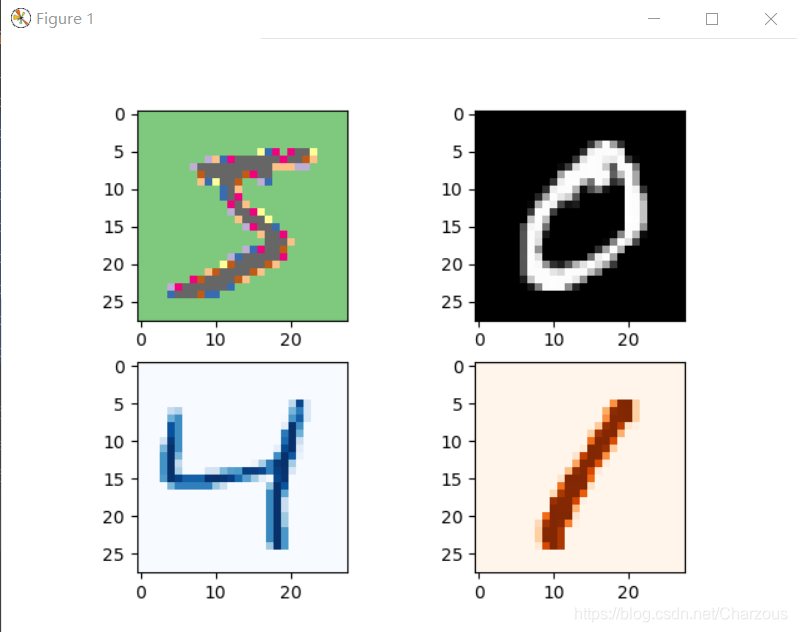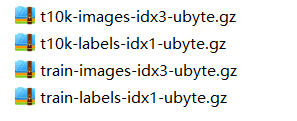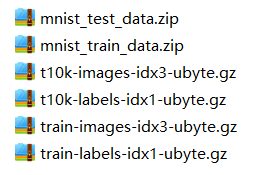前言
今天记录一下深度学习的另外一个入门项目——《mnist数据集手写数字识别》,这是一个入门必备的学习案例,主要使用了tensorflow下的keras网络结构的Sequential模型,常用层的Dense全连接层、Activation激活层和Reshape层。还有其他方法训练手写数字识别模型,可以基于pytorch实现的,《Pytorch实现基于卷积神经网络的面部表情识别(详细步骤)》 这篇就是基于pytorch实现,pytorch里也封装了mnist的数据集,实现方法应该类似,正在学习中……
这一篇记录则是基于keras的Sequential模型实现的。
1、mnist手写数字真面目
我们使用离线下载的数据集进行导入,一定程度上解决了从远程加载数据缓慢的问题,这里有两种数据集提供给大家,分别是:
- mnist.npz数据集
它是把手写数字的图像数据和对应标签集成在一起,而且训练集与测试集也在里面,使用的时候无需拆分文件,只需要简单代码划分数据,可直接下载本地 mnist手写数字识别数据集npz文件.zip - mnist.zip数据集
它包含了两个压缩包,分别是训练集和测试集(文件名:mnist_traint_data.zip和mnist_test_data.zip),每个数据集解压后里面分别是数据和对应的标签,所以最后由4个文件,可直接下载本地 mnist训练数据+测试数据(手写数字识别).zip
1.1、mnist.npz(集成)数据集
下载好mnist手写数字识别数据集npz文件.zip之后,解压得到mnist.npz之后,我们这里开始写代码看看手写数字图像的真面目。
显示图像代码:
import numpy as np
import matplotlib.pyplot as plt
def load_mnist(): # 自定义加载数据
path = r'D:\mnist_data\mnist.npz' # 放置mnist.npz的目录。注意斜杠
f = np.load(path)
x_train, y_train = f['x_train'], f['y_train'] # 代码实现分离数据集里面的训练集和测试集以及对应标签
x_test, y_test = f['x_test'], f['y_test'] # x_train为训练数据,y_train为对应标签
f.close() # 关闭文件
return (x_train, y_train), (x_test, y_test)
def main():
(X_train, y_train_label), (test_image, test_label) = load_mnist() #后续可以显示训练数据的数字或者测试数据的
fig, ax = plt.subplots(nrows=5, ncols=5, sharex=True, sharey=True) # 显示图像
ax = ax.flatten()
for i in range(25):
img = X_train[i].reshape(28, 28)
# img = X_train[y_train_label == 8][i].reshape(28, 28) # 显示标签为8的数字图像
ax[i].set_title(y_train_label[i])
ax[i].imshow(img, cmap='Greys', interpolation='nearest')
ax[0].set_xticks([])
ax[0].set_yticks([])
plt.tight_layout()
plt.show()
if __name__ == '__main__':
main()
效果如下:

也可以花样输出:
代码:
import numpy as np
import matplotlib.pyplot as plt
def load_mnist():
path = r'D:\mnist_data\mnist.npz' # 放置mnist.npz的目录。注意斜杠
f = np.load(path)
x_train, y_train = f['x_train'], f['y_train'] # 代码实现分离数据集里面的训练集和测试集以及对应标签
x_test, y_test = f['x_test'], f['y_test'] # x_train为训练数据,y_train为对应标签
f.close() # 关闭文件
return (x_train, y_train), (x_test, y_test)
def main():
(X_train, y_train_label), (test_image, test_label) = load_mnist()
plt.subplot(221)#显示图像
plt.imshow(X_train[0], cmap=plt.get_cmap('Accent'))
plt.subplot(222)
plt.imshow(X_train[1], cmap=plt.get_cmap('gray'))
plt.subplot(223)
plt.imshow(X_train[2], cmap=plt.get_cmap('Blues'))
plt.subplot(224)
plt.imshow(X_train[3], cmap=plt.get_cmap('Oranges'))
plt.show()
if __name__ == '__main__':
main()
图像显示:

1.2、mnist数据集(训练测试数据与标签分离)
这里介绍第二中方法,也就是数据集是分离的,下载好mnist训练数据+测试数据(手写数字识别).zip之后,解压得到文件如图:

进去解压得到:

可以看到分别是训练集和测试集,包括数据和标签。
这种方法比较麻烦,没想到吧!^_ ^ ,大家可以选择第一种步骤简单
最后得到:

导入时候需要用到的是这些.gz文件。
显示图像代码:
import gzip
import os
import numpy as np
import matplotlib.pyplot as plt
local_file = 'D:\mnist_data'
files = ['train-images-idx3-ubyte.gz', 'train-labels-idx1-ubyte.gz',
't10k-images-idx3-ubyte.gz', 't10k-labels-idx1-ubyte.gz']
def load_local_mnist(filename):# 加载文件
paths = []
file_read = []
for file in files:
paths.append(os.path.join(filename, file))
for path in paths:
file_read.append(gzip.open(path, 'rb'))
# print(file_read)
train_labels = np.frombuffer(file_read[1].read(), np.uint8, offset=8)#文件读取以及格式转换
train_images = np.frombuffer(file_read[0].read(), np.uint8, offset=16) \
.reshape(len(train_labels), 28, 28)
test_labels = np.frombuffer(file_read[3].read(), np.uint8, offset=8)
test_images = np.frombuffer(file_read[2].read(), np.uint8, offset=16) \
.reshape(len(test_labels), 28, 28)
return (train_images, train_labels), (test_images, test_labels)
def main():
(x_train, y_train), (x_test, y_test) = load_local_mnist(local_file)
fig, ax = plt.subplots(nrows=6, ncols=6, sharex=True, sharey=True)#显示图像
ax = ax.flatten()
for i in range(36):
img=x_test[i].reshape(28,28)
# img = x_train[y_train == 8][i].reshape(28, 28) # 显示标签为8的数字图像
ax[i].set_title(y_train[i])
ax[i].imshow(img, cmap='Greys', interpolation='nearest')
ax[0].set_xticks([])
ax[0].set_yticks([])
plt.tight_layout()
plt.show()
if __name__ == '__main__':
main()
输出结果:

2、Sequential模型训练
这里实现主要使用了tensorflow下的keras网络结构的Sequential模型,常用层的Dense全连接层、Activation激活层和Reshape层。tensorflow安装有问题可参考《初入机器学习,正确安装tensorflow、python版本匹配(Import:DLL load failed等问题解决)》
模型比较简单,网络搭建以及模型选择的损失函数、优化器可见代码。
import numpy as np
import os
import gzip
from tensorflow import keras
from tensorflow.keras.optimizers import SGD
from tensorflow_core.python.keras.utils import np_utils
from tensorflow.keras.layers import Dense, Dropout, Activation
local_file = 'D:\mnist_data'
files = ['train-images-idx3-ubyte.gz', 'train-labels-idx1-ubyte.gz',
't10k-images-idx3-ubyte.gz', 't10k-labels-idx1-ubyte.gz']
def load_local_mnist(filename): # 加载文件
paths = []
file_read = []
for file in files:
paths.append(os.path.join(filename, file))
for path in paths:
file_read.append(gzip.open(path, 'rb'))
# print(file_read)
train_labels = np.frombuffer(file_read[1].read(), np.uint8, offset=8) # 文件读取以及格式转换
train_images = np.frombuffer(file_read[0].read(), np.uint8, offset=16) \
.reshape(len(train_labels), 28, 28)
test_labels = np.frombuffer(file_read[3].read(), np.uint8, offset=8)
test_images = np.frombuffer(file_read[2].read(), np.uint8, offset=16) \
.reshape(len(test_labels), 28, 28)
return (train_images, train_labels), (test_images, test_labels)
def load_data():# 加载模型需要的数据
(x_train, y_train), (x_test, y_test) = load_local_mnist(local_file)
number = 10000
x_train = x_train[0:number]
y_train = y_train[0:number]
x_train = x_train.reshape(number, 28 * 28)
x_test = x_test.reshape(x_test.shape[0], 28 * 28)
x_train = x_train.astype('float32')
x_test = x_test.astype('float32')
y_train = np_utils.to_categorical(y_train, 10)
y_test = np_utils.to_categorical(y_test, 10)
x_train = x_train
x_test = x_test
x_train = x_train / 255
x_test = x_test / 255
return (x_train, y_train), (x_test, y_test)
(X_train, Y_train), (X_test, Y_test) = load_data()
model = keras.Sequential()# 模型选择
model.add(Dense(input_dim=28 * 28, units=690,
activation='relu')) # tanh activation:Sigmoid、tanh、ReLU、LeakyReLU、pReLU、ELU、maxout
model.add(Dense(units=690, activation='relu'))
model.add(Dense(units=690, activation='relu')) # tanh
model.add(Dense(units=10, activation='relu'))
model.compile(loss='mse', optimizer=SGD(lr=0.1),
metrics=['accuracy']) # loss:mse,categorical_crossentropy,optimizer: rmsprop 或 adagrad、SGD(此处推荐)
model.fit(X_train, Y_train, batch_size=100, epochs=20)
result = model.evaluate(X_test, Y_test)
print('TEST ACC:', result[1])
经过稍微调优,发现输入层激活函数使用relu和tanh效果好,其他网络层使用relu。另外,损失函数使用了MSE(均方误差),优化器使用 SGD(随即梯度下降),学习率learning rate调到0.1,度量常用正确率。
参数batch_size=100, epochs=20,增加参数更新以及训练速度。
以上参数以及选择训练效果如下:

使用优化器为adagrad效果:

大家也可以自行各种尝试,优化器和损失函数选择,参数调优等,进一步提高正确率。
这里提供另一种写法,模型构建类似。
import tensorflow as tf
from tensorflow.keras import datasets, layers, optimizers, models, metrics
from tensorflow.keras.optimizers import SGD
import os
os.environ['TF_CPP_MIN_LOG_LEVEL'] = '2' # 忽略tensorflow版本警告
(xs, ys), _ = datasets.mnist.load_data()
print('datasets:', xs.shape, ys.shape, xs.min(), xs.max())
# tf.compat.v1.enable_eager_execution()
tf.enable_eager_execution()
xs = tf.convert_to_tensor(xs, dtype=tf.float32) / 255.
db = tf.data.Dataset.from_tensor_slices((xs, ys))
db = db.batch(100).repeat(20)
network = models.Sequential([layers.Dense(256, activation='relu'),
layers.Dense(256, activation='relu'),
layers.Dense(256, activation='relu'),
layers.Dense(10)])
network.build(input_shape=(None, 28 * 28))
network.summary()
optimizer = optimizers.SGD(lr=0.01)
acc_meter = metrics.Accuracy()# 度量正确率
for step, (x, y) in enumerate(db):
with tf.GradientTape() as tape:
# [b, 28, 28] => [b, 784] 784维=24*24
x = tf.reshape(x, (-1, 28 * 28))#-1的含义,数组新的shape属性应该要与原来的配套,根据剩下的维度计算出数组的另外一个shape属性值。
# [b, 784] => [b, 10]
out = network(x)
# [b] => [b, 10]
y_onehot = tf.one_hot(y, depth=10) # 独热编码,y = 0 对应的输出是[1,0,0,0,0,0,0,0,0,0],范围0-9,depth深度10层表示10个数字
# [b, 10]
loss = tf.square(out - y_onehot)# 计算模型预测与实际的损失
# [b]
loss = tf.reduce_sum(loss) / 32
acc_meter.update_state(tf.argmax(out, axis=1), y)
grads = tape.gradient(loss, network.trainable_variables)# 计算梯度
optimizer.apply_gradients(zip(grads, network.trainable_variables))
if step % 200 == 0:
print(step, 'loss:', float(loss), 'acc:', acc_meter.result().numpy())
acc_meter.reset_states()
最后正确率比上面好一点,如图:

写在后面
经过这次mnist手写数字识别案例的学习,感觉收获了许多,之前只是在深度学习理论知识上的理解,现在配合代码实践,模型训练,理解更加深刻,还存在不足,欢迎大家指正交流,这个过程的详细步骤,希望能帮助跟我一样入门需要的伙伴,记录学习过程,感觉总结一下很好,继续加油!
我的CSDN博客:mnist手写数字识别深度学习入门项目(tensorflow+keras+Sequential模型)
我的博客园: mnist手写数字识别——深度学习入门项目(tensorflow+keras+Sequential模型)
mnist数据集我放到了CSDN,如果下载不了的伙伴评论留言哦!